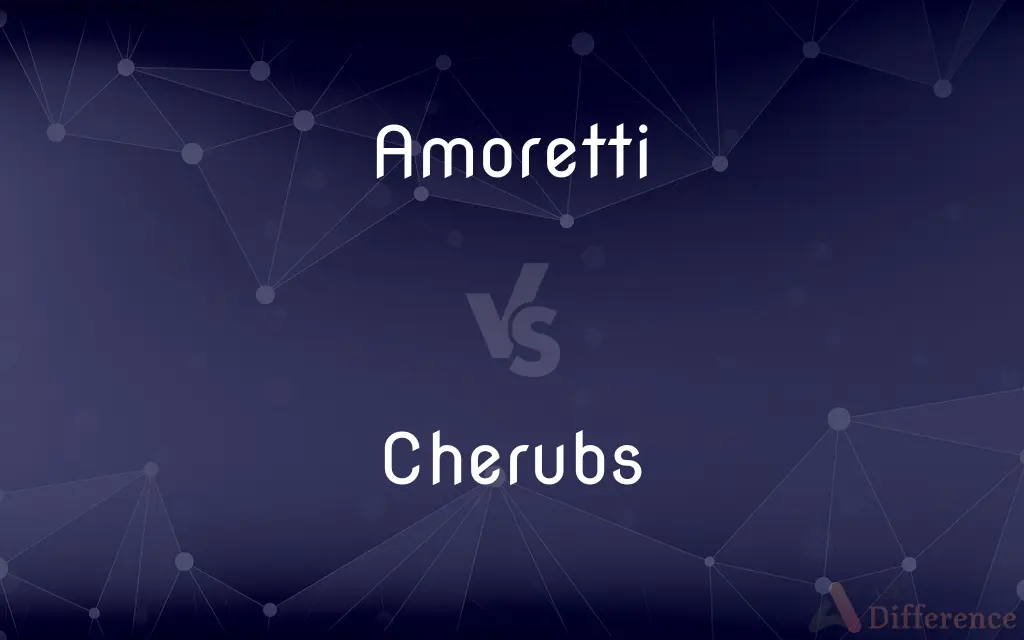Amoretti vs. Cherubs — What's the Difference?
By Tayyaba Rehman — Published on October 23, 2023
Amoretti refers to cupids in art or literature, often depicted as naked, winged boys shooting arrows, while cherubs are angelic beings, typically represented as innocent, rosy-cheeked children with wings.

Difference Between Amoretti and Cherubs
Table of Contents
ADVERTISEMENT
Key Differences
Amoretti and cherubs, while both depicted with wings and often as children, represent different concepts within art, literature, and theology. Amoretti are essentially depictions of cupids, synonymous with representations of love and desire, commonly portrayed as playful, winged boys, often naked, with bows and arrows, inspiring love in their targets. They are figures in mythology and are often associated with Venus, the goddess of love, and are symbols of love and desire in Western art and literature.
Cherubs, on the other hand, are beings from religious theology, specifically from Christian and Judaic traditions. Cherubs are considered to be angels, represented as innocent, rosy-cheeked, chubby children with wings, but traditionally they are described as formidable, multi-winged, multi-faced celestial beings who are attendants of God. Cherubs are seen as guardians, symbols of protection and divine watchfulness, often portrayed guarding the gates of paradise or surrounding God’s throne.
In art and literature, the depiction of amoretti and cherubs often overlaps, with both being portrayed as winged children, but their symbolic meanings and origins diverge significantly. Amoretti, being the embodiments of earthly love and desire, are often portrayed causing mischief and arousing love among mortals, adding a playful and romantic element to the artworks. They symbolize human passions, the joys and sorrows of love, and are ubiquitous symbols during the Renaissance period.
Cherubs, in contrast, are primarily symbols of divine love and presence, associated with purity and innocence. They have a more solemn and sacred role in religious narratives, representing a spiritual connection between the divine and the human, appearing in religious artworks and texts as messengers or attendants of God, emphasizing their divine and protective nature.
When exploring the nuances between amoretti and cherubs, it is essential to consider their distinct symbolic representations and their roles within their respective domains. Amoretti, as symbols of romantic love and desire, offer artistic expressions of human emotions and experiences, while cherubs, with their association with the divine and the celestial, elevate the concepts of love and protection to a spiritual realm, representing divine love and guardianship.
ADVERTISEMENT
Comparison Chart
Definition
Cupids in art or literature
Angelic beings in religious theology
Origin
Mythology, associated with Venus
Religious, particularly in Christian and Judaic traditions
Represents
Love and desire
Divine presence, protection
Depiction
Naked, winged boys with arrows
Typically innocent, rosy-cheeked children with wings
Symbolic Meaning
Human passions, the joys and sorrows of love
Purity, innocence, and divine love
Compare with Definitions
Amoretti
Amoretti symbolize love and desire.
Amoretti often grace the pages of romantic poetry, spreading the aura of love.
Cherubs
Cherubs are angelic beings, typically representing divine presence and protection.
The cherubs were depicted guarding the gates of paradise in the ancient fresco.
Amoretti
Amoretti are associated with Venus, the goddess of love.
Amoretti, with their mischievous smiles, are seen as attendants to Venus in many artworks.
Cherubs
Cherubs symbolize purity and divine love.
The presence of cherubs in religious art often denotes themes of divine love and protection.
Amoretti
Amoretti are often depicted causing mischief and arousing love among mortals.
The artist’s portrayal of amoretti cleverly illustrated their role in stirring passions among humans.
Cherubs
Cherubs are also seen as guardians and messengers of God.
In many religious texts, cherubs are depicted delivering messages from God to humans.
Amoretti
Amoretti are depictions of cupids in art and literature.
The painting was adorned with playful amoretti, each holding a golden arrow.
Cherubs
Cherubs are often portrayed as innocent, rosy-cheeked children with wings.
Cherubs, with their innocent faces, often adorn the ceilings of churches.
Amoretti
Amoretti are usually portrayed as winged boys.
The amoretti in the sculpture were depicted with delicate wings and cheeky expressions.
Cherubs
Cherubs are considered attendants of God in religious theology.
Cherubs are seen surrounding God’s throne, emphasizing their role as divine attendants.
Amoretti
Amoretti is a sonnet cycle written by Edmund Spenser in the 16th century. The cycle describes his courtship and eventual marriage to Elizabeth Boyle.
Cherubs
A winged celestial being.
Amoretti
A cupid.
Cherubs
Cherubim(Christianity) The second of the nine orders of angels in medieval angelology.
Amoretti
Plural of amoretto
Cherubs
A putto.
Cherubs
A person, especially a child, with an innocent or chubby face.
Cherubs
Plural of cherub
Common Curiosities
What do cherubs represent?
Cherubs are angelic beings representing divine presence, protection, and love in religious theology.
Are amoretti associated with any deity?
Yes, amoretti are often associated with Venus, the goddess of love.
Are cherubs depicted as children?
Cherubs are often artistically depicted as innocent, rosy-cheeked children with wings.
What are amoretti?
Amoretti are representations of cupids in art and literature, symbolizing love and desire.
Do amoretti have wings?
Yes, amoretti are typically depicted as winged boys holding arrows.
Are amoretti considered mischievous?
Often, amoretti are portrayed as playful and mischievous, causing mischief and arousing love among mortals.
Do cherubs have a protective role?
Yes, cherubs are seen as guardians and symbols of divine protection in religious narratives.
Are cherubs considered divine?
Yes, cherubs are considered divine beings, often seen as attendants of God in religious traditions.
Share Your Discovery

Previous Comparison
Surprise vs. Trap
Next Comparison
Local vs. NearbyAuthor Spotlight
Written by
Tayyaba RehmanTayyaba Rehman is a distinguished writer, currently serving as a primary contributor to askdifference.com. As a researcher in semantics and etymology, Tayyaba's passion for the complexity of languages and their distinctions has found a perfect home on the platform. Tayyaba delves into the intricacies of language, distinguishing between commonly confused words and phrases, thereby providing clarity for readers worldwide.












































